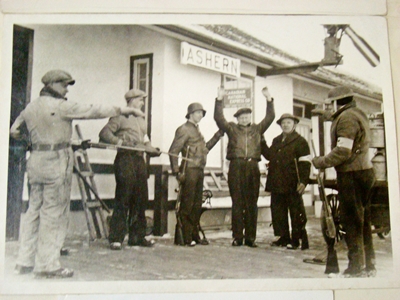This article appeared in the Nov. 7, 2012 issue of the Interlake Enterprise.
…By Teresa Carey
Each November 11 Canada pauses to remember our war veterans, past and present, through ritualized gatherings at cenotaphs, schools and other public gathering places. Wreathes are laid in honour of those lost and the victories of war are acknowledged with pride. For those who have fought in wars, or those whose friends and family had fought, “Lest we Forget” are not merely words, but are the very essence of Remembrance Day. However, like all words, the phrase is sometimes inadequate to convey the raw experience of war, the stress on a society, the suffering and pain of soldiers and families. For those who lived it, all is remembered in the shared moments of silence. For those who have not, the Remembrance Day experience is necessarily quite different.
The world has changed and the memories of war are difficult to convey to those who have not lived through it. Time passes. One generation makes way for the next. Each step forward moves a society further from its former understandings. Cultures change and the markers and signs which convey previously shared meanings become faded. One needs only to enter a museum and browse through the strange artefacts housed therein to feel perplexed at the array of items common in our grandparents’ time.
To bridge the divide in understanding takes work by both the older and younger generations. Youth must put themselves at the disposal of their elders. They must become like open vessels and try to fathom a foreign reality. Elders, in turn, must be willing to share–to divulge truth deeply, to fill the open minds of youth with relatable memories, no matter how different-thinking the generations have become.
People preserve things in museums for a reason. It is so not to forget–something important, that is.
Museum artefacts, in all their strangeness, can trigger the latches that may throw open the doors to a new understanding.
Many museums, even here in the Interlake, house war memorabilia of all sorts, from bandages, ammunition and gas masks, to medals of bravery, proud uniforms, and letters home. There is a story behind each and every one of these, and it is worth spending as much time as possible contemplating them.
Photos of people past are abundant in any museum. Each of them tells an interesting tale, whether by the look in a subject’s eyes, or by the activities represented in the pictures.
A fascinating series of photos exist at the Ashern Pioneer Museum. In the north-east room a half dozen black and white photos had been mounted on poster paper, covered with plastic, and affixed to the wall. They depict scenes of men in Nazi uniforms surrounding local citizens with rifles. In one photo a man stands blind-folded.
Seventy-nine-year-old June Price, who has been on the Ashern Pioneer Museum board since 1982, explained what was happening in the pictures. She told of how a group of Ashern’s men dressed in Nazi uniforms and “held up” businesses around Ashern to see what it would feel like if the Nazis were to invade their town. Shop owners were surrounded, held at gun point then arrested. Many were completely caught by surprise, Price said.
Price was not sure of the precise date this occurred, other than it took place in the 1940s.
“The men were sitting around having coffee. One man said to the other, ‘I wonder what it would feel like if the Nazis came to Ashern and took it over,” Price said. “Nobody knew this was happening, but they decided to do this. They arrested the station master, then they went to Harry Schwartz’s general store and arrested everyone there… and they also went to the Ashern Farmer’s Creamery.”
These events were enacted once again during Ashern’s Millennium festivities in 2000. Price, who was inspired by those photos, had written scripts for some historical skits, including one on the takeover. Visitors then acted out the skits on the museum grounds. The photos documenting the Millennium celebration now share a place with the original photos in the north-east room.
The Ashern men’s hoax closely resembles an historical event that happened in Winnipeg on Feb. 19, 1942, and may even have derived from it. The event was called “If Day”. This took place in the midst of the second world war when funds were needed to support the war effort. A plan was hatched by the manager of the Greater Winnipeg Victory Loan Organization to help promote the sale of victory bonds by scaring Winnipegers with the threat of a Nazi invasion.
Even though the ad campaign was well-advertised, there were many who had not heard about it. One can only imagine the horror they must have felt when the air raid sirens sounded and 3,500 “Nazi” troops descended upon them. The volunteers dressed as Nazis staged fire fights, went door to door arresting people, and generally harassed the Winnipeg population. Nearby towns also participated in the event.
The result was that after about 18 hours of invasion, the entire province of Manitoba fell to the “enemy”. Organizers must have been pleased at the more than $3 million that was raised by the end of the day.
A generation or two later, such an enactment seems hardly believable, and would never be allowed for various reasons. However, putting oneself in the place of any of those people and imagining oneself going through the motions may be one way to help us connect with those who directly experienced war times. It may serve as another way we can help to bridge the gap in our understanding, perhaps giving us a greater appreciation of what Remembrance Day is all about.
(Ashern “If Day” photo: Joe Schwartz played a Nazi Fred O’Connell was Ashern’s Station Master. Other participants’ names are not known.)



